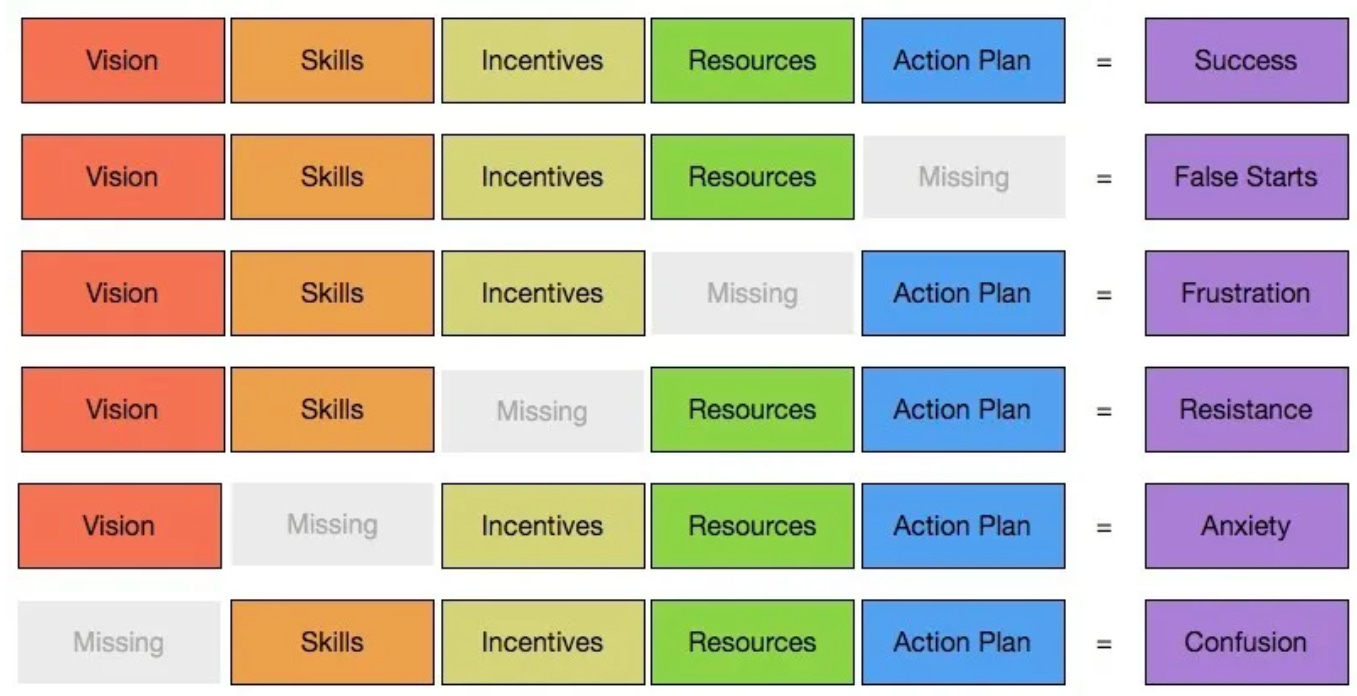Embracing Change in Education
Using the Knoster Model for Lasting Transformation
During a recent district-wide professional development session, we explored the Knoster Model for Lasting Change, a framework designed to guide meaningful transformation. Developed by Tim Knoster, this model identifies five essential components for implementing lasting change: vision, skills, incentives, resources, and an action plan. It builds on Dr. Mary Lippitt’s "Managing Complex Change" model (1987), which emphasizes these same elements as critical to success.
Now, let’s apply this concept to teaching.
If you've ever taught a lesson and been met with blank stares, you know that moment of doubt—it feels like you’re suddenly speaking a different language. Instantly, questions flood your mind:
Was the content too advanced?
Did my students have the skills to engage with it?
Was my pacing appropriate?
Did I deliver the lesson effectively?
It’s frustrating, and let’s be honest—defeating. But that’s where the Knoster Model comes in. It’s like a roadmap that helps break down change into a structured, thoughtful process rather than just throwing a new strategy at the wall and hoping it sticks..
The 5 Key Components of the Knoster Model
Vision
Skills
Incentives
Resources
Action Planning
Applying the Knoster Model to Teaching
Vision
First, we need a clear and shared vision. If you've ever led a group—especially younger students—without a clear goal, you know how quickly things can become chaotic. Whether it’s working toward a classroom objective or meeting district standards, everyone—teachers, students, and administrators—must be aligned. Without a unified vision, it's like following a treasure map while half the group is reading it upside down.
Skills
We can’t just wish for change—we need the skills to make it happen. Professional development and ongoing training are essential. Teachers need tools to implement new strategies, whether it’s introducing new tech, refining curriculum, or improving pedagogy.
And if something doesn't make sense? It’s okay to ask for support. Let’s be real, sometimes you don't know what grade you'll be teaching until the beginning of the school year! A teacher at one of the schools I worked at was hired as a kindergarten teacher and had to transition into teaching 6th grade after the first week of school : transitioning to teaching lower grades can be a huge shift. One day, you’re diving into letter sounds, and the next, you’re dusting off your knowledge of decimal division. We’ve all had to brush up on skills!
Incentives
Change is hard, so motivation is key. Incentives can come in different forms—seeing engaged students, receiving peer recognition, or just experiencing that “aha” moment when a student finally gets it.
And let’s be honest, sometimes teachers need their own growth mindset too. I always think about that Abbott Elementary Episode where Mrs. Howard says, “Well, it worked before, so why change it?” Embracing change takes encouragement, and that’s where incentives play a big role.
Resources
Here’s the thing—resources matter. Teachers need time, materials, and support to implement change effectively. Otherwise, it’s like trying to run a marathon in flip-flops—you might finish, but it’ll be way harder than it needs to be.
Proper resources—whether it’s planning time, collaboration with colleagues, or administrative support—can make all the difference between effective implementation and another initiative that fizzles out.
Action Planning
Finally, we need a clear action plan. Change doesn’t just happen—it requires structure. A well-thought-out plan helps break things down into manageable steps, making the transition smoother.
Think of it like driving across town. You could wing it, but using a GPS (aka a strategic plan) makes the trip a whole lot easier.
The Power of Reflection and Adaptation
One of the most valuable lessons I’ve learned is that meaningful change takes time—whether it's personal growth or a school-wide transformation, it doesn't happen overnight. The Knoster Model serves as a powerful reminder to slow down, reflect, and adapt, embodying the essence of a true growth mindset.
By applying this model, educators can identify the root causes of learning breakdowns and develop targeted strategiesto ensure lessons are clear, engaging, and accessible for all students.


